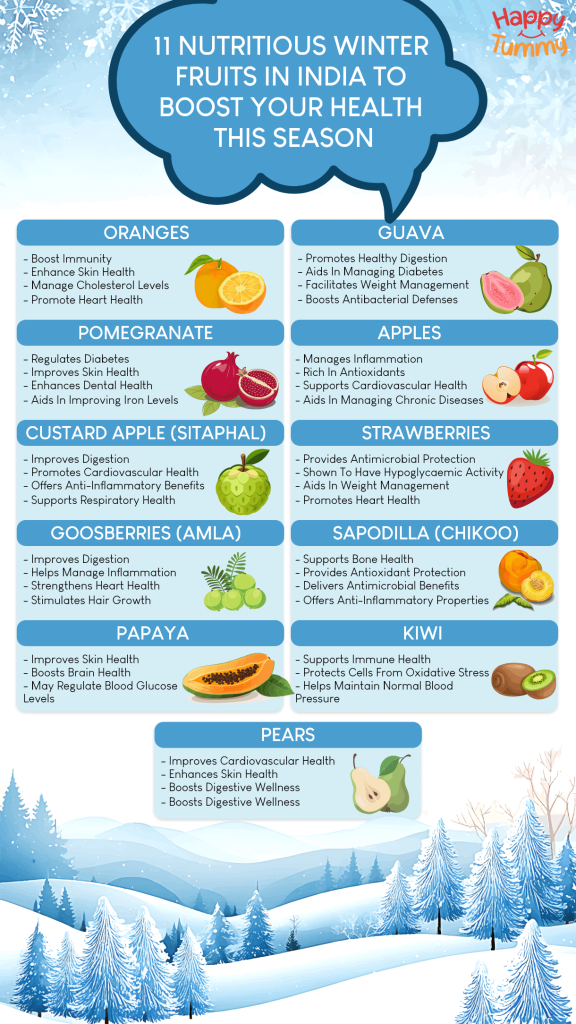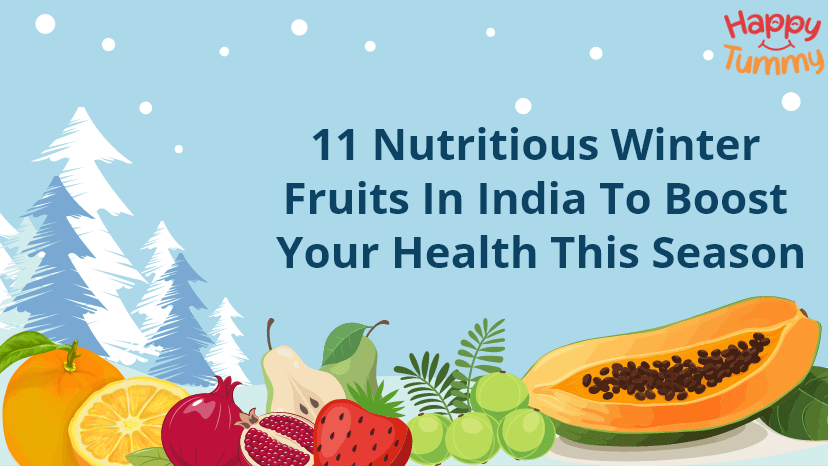Table of Contents
As winter approaches, temperatures drop, days grow shorter, and our immunity faces new challenges.
We may be more vulnerable to seasonal illnesses like colds, the flu, and respiratory infections due to cold weather, dry air, and our tendency to spend more time indoors. However, winter need not be a time of illness!
Did you know that your secret weapon for remaining healthy during the winter months may be eating the right fruits?
Winter fruits, which are rich in vitamins, minerals, and other vital components, are not only tasty but also have the potential to improve your immune system.
Read on the article to explore the various winter fruit and the bounty of benefits they provide to your health.
11 Winter Fruits in India
The fruits mentioned here are known as winter fruits as they grow well and are available in plenty during the winter season in India.
These fruits are winter fruits not only in the sense that they ripe during this period but because they are also helpful to our bodies during winter.
Winter brings us changes at all levels of our systems and these changes can be taxing on the immune system.
These fruits contain natural nutrients such as Vitamin C, antioxidants and micronutrients, which make the body immune to diseases such as the common cold, among others.

#1 Oranges
You should undoubtedly have your share of oranges if you like citrus fruits. Oranges are recognised for their juicy, tangy-sweet flavour and are usually spherical with sparkling orange peel.
They are mostly grown in Maharashtra, Andhra Pradesh, Tamil Nadu, Karnataka, Punjab, and a few areas in the northeast of India.
In addition to being delicious, oranges are one of the most popular fruits in the world. Along with many other vitamins, minerals, and antioxidants, they are a good source of vitamin C [53.2 mg per 100 grams].[1]
The nutrients in oranges offer a range of health benefits: [1]
- Boost Immunity
- Enhance Skin Health
- Manage Cholesterol Levels
- Supports Blood Sugar Management
- Improve Eyesight
- Promote Heart Health
#2 Guava
Guavas are tropical fruits that are round or oval in shape, have sweet, a bit tart flesh that can vary in colour from white to pink depending on the variety. This fruit often have green skin that can turn yellow when mature.
Guavas are a staple fruit in many parts of India, where they are grown extensively in states like Bihar, Uttar Pradesh, Maharashtra, Karnataka, and Andhra Pradesh.
It isn’t just any fruit, though; it’s your ticket to a world where health and flavour come together in the most amazing manner. Imagine enjoying a fruit that is a nutritional powerhouse in addition to being delicious.
Vitamin C, potassium, phosphorus, and other vital minerals are also abundant in guavas. Let’s see how these nutrients in guava benefit us. [2]
- Promotes Healthy Digestion
- Assists in Oral Cavity Problems
- Boosts Antibacterial Defenses
- Aids in Managing Diabetes
- Facilitates Weight Management
You could occasionally experience confusion over your digestive quotient. With Aashirvaad Digestive Quotient, however, things become more manageable.
The Digestion Quotient test, created by Aashirvaad Atta with Multigrains and a team of professional nutritionists, determines your digestion score on a scale of 100.
#3 Pomegranate
An “anar,” the Hindi term for pomegranate, is a big, spherical fruit with many tiny, jewel-like crimson seeds (called arils) within that are the edible portion. The skin is thick and leathery.
Pomegranates taste sweet and sour when consumed.
Maharashtra is the only state where pomegranates are grown commercially on a large scale. Gujarat, Rajasthan, Karnataka, Tamil Nadu, Andhra Pradesh, Uttar Pradesh, Punjab, and Haryana are also home to small-scale plantations.
Fruit can be eaten fresh or as juice, jam, squash, or syrup.
Because they are rich in nutrients and potent antioxidants, pomegranates may provide health benefits: [3] [4]
- Supports Weight Management
- Regulates Diabetes
- Improves Skin Health
- Provides Antioxidant Support
- Enhances Dental Health
- Aids in Improving Iron Levels
#4 Apples
Depending on the variety, apples in India are usually characterised by their juicy, crisp texture and sweet to slightly tangy flavour.
The hilly areas of Uttarakhand, Himachal Pradesh, and Jammu & Kashmir are the main locations for this fruit’s cultivation.
Depending on the variety, the fruit may seem brilliant red or greenish-yellow. Nutrients including fibre, vitamin C, and antioxidants found in apples may assist weight management, cognitive wellness, and a healthy digestive system.
They offer a variety of nutrients that can improve a person’s health in numerous ways. [5]
- Manages Inflammation
- Rich in Antioxidants
- Supports Cardiovascular Health
- Aids in Managing Chronic Diseases
#5 Custard Apple (Sitaphal)
Known as “sitaphal” in India, custard apples are tropical fruits with green, rough skin. The fruit contains many dark brown seeds imbedded in the flesh and a smooth, creamy white pulp that tastes sweet and custard-like.
It is mostly grown in India’s warm, tropical climate; Telangana, Tamil Nadu, Maharashtra, and Bihar are the main growing regions.
Due to the abundance of nutrients in the fruit, custard apples have several health benefits. [6]
- Enhances Immune Function
- Improves Digestion
- Promotes Cardiovascular Health
- Offers Anti-Inflammatory Benefits
- Supports Respiratory Health
#6 Strawberries
Strawberries are little, heart-shaped fruits that have a sweet, somewhat tangy flavour, a juicy texture, and a vivid red colour.
They are mostly grown in moderate climates in Tamil Nadu, Maharashtra (especially Mahabaleshwar), and Himachal Pradesh in India.
Strawberries are an excellent addition to a healthy diet, especially when you eat them on their own. They are tasty and packed with nutrients that are excellent for you.
Strawberries are naturally low in sugar, yet they taste good. It’s difficult to top that mix. This winter fruit has the following health benefits: [7]
- Provides Antimicrobial Protection
- Shown to Have Hypoglycaemic Activity
- Aids in weight management
- Promotes Heart Health
#7 Goosberries (Amla)
A gooseberry looks similar to a small grape, with a translucent skin. They come in a variety of colours, including green, yellow, pink, red, and purple. The green ones are more sour, while the red and purple ones are sweeter.
Depending on their level of ripeness, they have a juicy interior with tiny seeds inside, and their taste is usually described as acidic and slightly sweet.
Due to their high nutritional content and therapeutic qualities, gooseberries, also known as “amla” (Emblica officinalis), are widely grown in India, especially in regions like Tamil Nadu, Madhya Pradesh, and Uttar Pradesh.
Because of its high vitamin C content and antioxidant qualities, this fruit is a mainstay in traditional Indian medicine and cooking. The health benefits of amla are as follows: [8]
- Helps Manage Inflammation
- Supports Diabetes Management
- Improves Digestion
- Strengthens Heart Health
- Benefits Eye Health
- Stimulates Hair Growth
#8 Sapodilla (Chikoo)
A chikoo, often called a sapota, is a tropical fruit with a delicate, translucent, yellowish-orange flesh that has a gritty feel and a brown, slightly fuzzy skin.
When mature, it has a sweet, malty flavour that is sometimes likened to pear or brown sugar, with a faint note of vanilla.
When unripe, it can have a somewhat astringent taste. Its flesh contains a number of big, black seeds.
Because of its adaptability for tropical climates, this winter fruit is mostly grown in India, especially in states like Gujarat, Karnataka, Tamil Nadu, Maharashtra, Andhra Pradesh, and Kerala.
The advantages of chikoo are numerous because of its great nutritional value. [9]
- Offers Anti-Inflammatory Properties
- Supports Bone Health
- Provides Antioxidant Protection
- Delivers Antimicrobial Benefits
#9 Papaya
A papaya is a tropical fruit with thin, silky skin that turns yellow or orange when mature. Its flesh is bright orange or pink, and it tastes sweet and somewhat melon-like.
There are many tiny, peppery-flavored, black, edible seeds in the fruit’s centre. This winter fruit smells good and has a soft, juicy feel when mature.
Andhra Pradesh, Karnataka, Gujarat, Orissa, West Bengal, Assam, Kerala, Madhya Pradesh, and Maharashtra are the principal papaya-growing states in India.
With its remarkable collection of vital minerals, vitamins, and antioxidants, papaya is a great nutritional powerhouse. The following are some of its health advantages: [10]
- Manages Inflammation and Oxidative Stress
- May Regulate Blood Glucose Levels
- Boosts Brain Health
- Improves Skin Health
#10 Kiwi
Kiwi has fuzzy brown skin and brilliant green or golden meat with small edible black seeds.
Its distinct, sweet, and tangy flavour is sometimes compared to a combination of melon, pineapple, and strawberry. When ripe, it has a delicate, juicy feel.
Since kiwis grow well in chilly, temperate temperatures with moderate to high rainfall, they are mostly grown in the mountainous areas of states like Himachal Pradesh, Uttarakhand, Jammu and Kashmir, Sikkim, Meghalaya, and Arunachal Pradesh in India.
Kiwi’s potassium, vitamin C, vitamin E, and folate provide the following health advantages: [11]
- Supports Immune Health
- Protects Cells from Oxidative Stress
- Helps Maintain Normal Blood Pressure
#11 Pears
Usually oval or bell-shaped, pears have smooth skins that can be either green or yellow. Depending on the variety, it has soft, white flesh with a sweet, juicy flavour and a faint surface texturing.
With a distinctive “grit” from the stone cells in the flesh, the texture can be buttery and somewhat gritty. When pears have a good scent and bend slightly under light pressure, they are said to be ripe.
Pear can be a good addition because of the following health benefits: [12]
- Manages the Risk of Chronic Diseases
- Improves Cardiovascular Health
- Aids in Maintaining a Healthy Weight
- Enhances Skin Health
- Boosts Digestive Wellness
Nutrient Profile of Winter Fruits
| Nutrient | Orange[13] | Guava[14] | Pomegranate[15] | Apple[16] | Custard Apple[17] | Strawberries[18] | Amla[19] | Chikoo[20] | Papaya[21] | Kiwi[22] | Pears[ 23] |
| Protein | 0.94 g | 1.44 g | 1.33 g | 0.46 g | 1.62 | 0.97 g | 0.34 g | 0.44 g | 0.50 g | 1.14 g | 0.36 g |
| Dietary Fiber | 2.4 g | 8.59g | 2.83 g | 2.59 g | 5.10 g | 2.50 g | 7.75 g | 5.3 g | 2.28 g | 3.0 g | 4.48 g |
| Vitamin C | 53.2 mg | 214 mg | 10.2 mg | 3.57 mg | 21.51 mg | 50.20 mg | 252 mg | 14.7 mg | 20.73 mg | 92.7 mg | 3.31 mg |
| Vitamin A | 11 µg | – | – | – | – | – | – | 3 µg | – | 4 µg | – |
| Folate (Vitamin B9) | 30 µg | 32.7 µg | – | 3.04 µg | 7.60 µg | 8.91 µg | 7.86 µg | 14 µg | 29.79 µg | 25 µg | 5.28 µg |
| Potassium | 181 mg | 417 mg | 206 mg | 116 mg | 278 mg | 153 mg | 223 mg | 193 mg | 173 mg | 312 mg | 106 mg |
| Calcium | 40 mg | 18.52 mg | 10.65 mg | 13.68 mg | 28.20 mg | 15.28 mg | 20.14 mg | 21 mg | 22.72 mg | 40 mg | 6.55 mg |
| Magnesium | 10 mg | 15.26 mg | 11.07 mg | 8.09 mg | 38.47 mg | – | 6.50 mg | 12 mg | 15.03 mg | 17 mg | 7.61 mg |
| Phosphorus | 14 mg | 23.54 mg | 27 mg | 10.44 mg | 40.81 mg | – | 21.85 mg | 12 mg | 24.11 mg | 34 mg | 6.74 mg |
| Iron | 0.1 mg | 0.32 mg | 0.31 mg | 0.26 mg | 0.42 mg | – | 1.25 mg | 0.8 mg | 0.20 mg | 0.31 mg | – |
Nutrient Analysis:
The table provides a detailed comparison of nutrients across various fruits. Guava and Amla emerge as nutrient powerhouses.
Guava excels in Vitamin C (214 mg), dietary fibre (5.4 g), and potassium (417 mg), while Amla offers the highest Vitamin C (252 mg) and the most dietary fiber (7.75 g).
Custard Apple is notable for its magnesium (38.47 mg) and dietary fibre (5.10 g).
Kiwi also shines with high Vitamin C (92.7 mg) and potassium (312 mg).
Oranges provide a balanced mix of nutrients, particularly Vitamin C (53.2 mg), while Chikoo is rich in fibre (5.3 g). Fruits like Pomegranate, Apple, and Pears contribute moderate nutrients, with apples offering more fiber (2.59 g) than Vitamin C.
Amla is a great complement to a balanced diet since it has the highest iron content (1.25 mg). Every fruit has a distinct contribution to total nutrition.
Sometimes, you may find it difficult to plan healthy meals and always look for strategies to increase your fibre intake. But wonder who to counsel and how to approach it.
Well, fear not, folks—Aashirvaad Atta with Multigrains and a team of trained nutritionists have created the My Meal Plan test, which may determine your daily fibre intake and provide you with a comprehensive meal plan that complies with recommended intake.
The End Note
These winter fruit are indeed a great addition to your diet. If you are someone who likes to munch on fruits directly, try including these as part of your regular meals or add them to healthy desserts.
Although it might be a fantastic addition to your diet, don’t forget to savour it as part of a balanced meal plan.
It’s always a good idea to speak with professionals for individualised advice on a healthy lifestyle! Our certified nutritionist would be pleased to assist you. Use the link to schedule your consultation with us.
Frequently Asked Questions
During the colder months, colds, flu, and other respiratory ailments are frequently more prevalent. Because people spend more time indoors, infections can spread more easily between people. Additionally, low humidity in colder months can allow viruses, especially those causing colds and flu, to survive and spread more quickly, further compromising our immune system’s ability to fend off infections.
Indeed, several foods, significantly those high in vitamin C, zinc, selenium & iron, such as apples, papaya, guava, kiwis, and oranges, can dramatically increase your immunity in the winter.
Absolutely! We must eat winter fruits during this period because they provide fibre and vitamins, especially vitamin C, for our skin to produce collagen and manage dryness, as most fruits like oranges, guavas, and strawberries are believed to be high in Vitamin C.
















